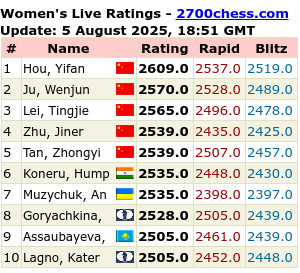Finally, and given the rating of my opponent, the fact that he plays 1.d4, and that I have Black, perhaps surprisingly, I gain my first win in T46.
I have admit that this week I have not played blitz to any extent (I checked : 3 games on Sunday) and spent the time instead on tactics training, reviewing some Master games, the analysis of my previous loss and some investigation into what to expect today.
The latter was a distinct 1.d4, which I have played against only once in my previous 15 TL games. As well as that, I don't really have a 'repertoire' against it, so it was a interesting opportunity.
On to the game...
As expected White opens 1. d4 Nf6 2. c4 d6 3. Nc3 Nbd7 4. e4 e5 5. Nf3 Be7 yes, you're right, its almost a Philidor, but there's a pawn on c4, so that makes it a Queen Pawn game, I suppose.
6. Bd3 This didn't seem quite correct to me, and the statistics back me up. In 2710 games its been played 41 times. The most obvious move is Be2, as that doesn't block the d-file and still prepares castling. Its not the reason for white losing, but surprisingly the statistics also say that Be2 scores 60% against only 48% for Bd3. Lucky we don't play by statistics !
6...exd4 ...and a good job we don't as this only comes up once and loses ( although not directly because of this move, of course ). I played this as I felt that it was better than waiting for white to play dxe5. The most obvious move is to castle, although it will just delay the decision. However, I think if Be2 was played exd4 is not so good as it allows Qxd4
7. Nxd4 O-O 8. O-O c5
 |
| 8...c5 |
9. Nf5 Ne5 10. Ng3
 |
| 10.Ng3 |
10...Bg4 11. f3 Be6 This seemed a decent position. Bg4 prompts f3, which closes the Queen in, and e6 is where I wanted the bishop anyway.
12. Qe2 a6
 |
| 12...a6 |
13. Nd5! Re8 Maybe Black should exchange ? Nxd5 14. Bf4 Ned7 Again, should Black exchange ? I declined and went for re-organisation 15. Rad1 A few moves later and this is the position...
 |
| 15. Rd1 |
15...Nb6 Another way around, hitting d5, and ready for Na4 and Nb2, which was the plan evolved
16. Bc2 Not sure why, possibly freeing the d-file for the rook, and preparing Qd3...b3 needs to be played at some point, and maybe Nxb6 was a good move here 16...Nfxd5 17. exd5 Bd7 I should have exchanged one, or two moves before, but was not sure if it should be bishop or knight, or what to do with the bishop after exd6. Bd7 is obvious, but I wasn't sure if is was good or bad. Exchanging is a key part of a plan, and, like comedy is best timed properly. 18. Qd3 Obvious and aiming for h7, mate, but what else could be played ?
18...g6 19. Bh6 I think this is not correct. Yet again, b3 is needed to safeguard the b- and c-pawns and prevent Na4.
19...f5
 |
| 19...f5 |
20. Rfe1 Bf6 Possibly Na4 is also good. Now that the b2 square provides a useful fork of rook and queen
21. b3 Finally...21...Bd4+ 22. Be3
 |
| 22.Be3 |
22...Rxe3 23. Rxe3 f4! and the material is re-gained
24. Nf1 Given what is coming up, 21.Ne4 fxe3 22.Qe2 Bf5 may be better, but I think White is in a difficult position anyway
24...fxe3 25. Nxe3 Its tempting to re-gain material, but now the knight is pinned. Perhaps better is Re2 or Qe2, blockading the pawn
25...Qg5 or Qe7 has the same effect, opening e8 for the rook 26. Re1 Re8 27. Kf2 Qh4+ 28. Kf1 Nxd5!
 |
| 28...Nxd5 ! |
29...Bb5 !
 |
| 20...Bb5! |
30. Qxb5 axb5 31. g3 Qh3+ and White resigns.....I could have taken more material with Qxh2 as well, but the point was to get behind the pawns.
Again, an enjoyable game regardless of the win. Prior to 22. Be3 I felt that I was doing OK, and keeping up with White. We both made mistakes, but didn't take advantage (especially white with 10.Ng3 ).
This and the last game show me that eliminating basic errors ( or even major blunders ) gives a much better game. The decision to capture with Rxe3 and not Bxe3, as well as the Nxd5 tactics are quite simple, when time is taken to check them, so I think the time spent on tactics and reduction of blitz may have contributed subconsciously.
I will probably return to this post after looking at the positions following 12. Qe2 and 15.Rd1.
I added a game from the St Petersburg tournament from 1909, where I found the idea. There are a few differences, especially the Be2 and Be3 placements. Its interesting to play through regardless of the opening as Tartakower is resisting for a long time....


0 comments:
Post a Comment